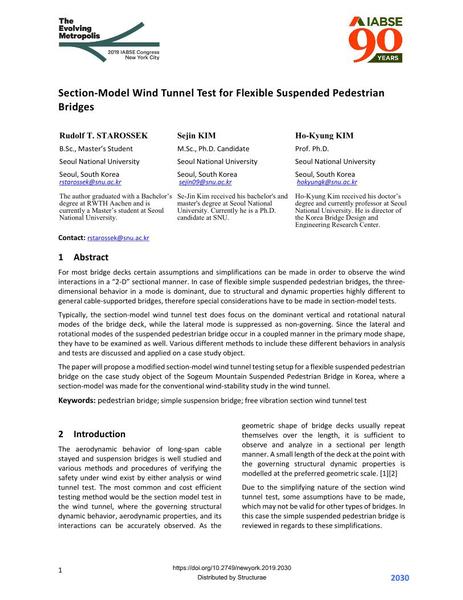Section-Model Wind Tunnel Test for Flexible Suspended Pedestrian Bridges

|
|
|||||||||||
Détails bibliographiques
| Auteur(s): |
Rudolf T. Starossek
Sejin Kim (Seoul National University) Ho-Kyung Kim |
||||
|---|---|---|---|---|---|
| Médium: | papier de conférence | ||||
| Langue(s): | anglais | ||||
| Conférence: | IABSE Congress: The Evolving Metropolis, New York, NY, USA, 4-6 September 2019 | ||||
| Publié dans: | The Evolving Metropolis | ||||
|
|||||
| Page(s): | 2030-2036 | ||||
| Nombre total de pages (du PDF): | 7 | ||||
| DOI: | 10.2749/newyork.2019.2030 | ||||
| Abstrait: |
For most bridge decks certain assumptions and simplifications can be made in order to observe the wind interactions in a “2-D” sectional manner. In case of flexible simple suspended pedestrian bridges, the three- dimensional behavior in a mode is dominant, due to structural and dynamic properties highly different to general cable-supported bridges, therefore special considerations have to be made in section-model tests. Typically, the section-model wind tunnel test does focus on the dominant vertical and rotational natural modes of the bridge deck, while the lateral mode is suppressed as non-governing. Since the lateral and rotational modes of the suspended pedestrian bridge occur in a coupled manner in the primary mode shape, they have to be examined as well. Various different methods to include these different behaviors in analysis and tests are discussed and applied on a case study object. The paper will propose a modified section-model wind tunnel testing setup for a flexible suspended pedestrian bridge on the case study object of the Sogeum Mountain Suspended Pedestrian Bridge in Korea, where a section-model was made for the conventional wind-stability study in the wind tunnel. |
||||
| Mots-clé: |
passerelle piétonnne
|
||||


